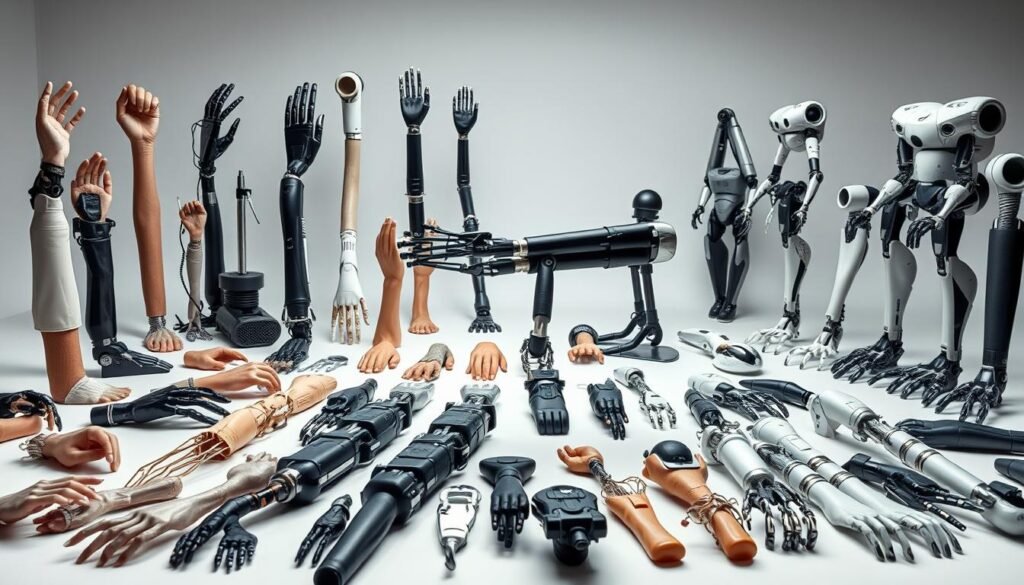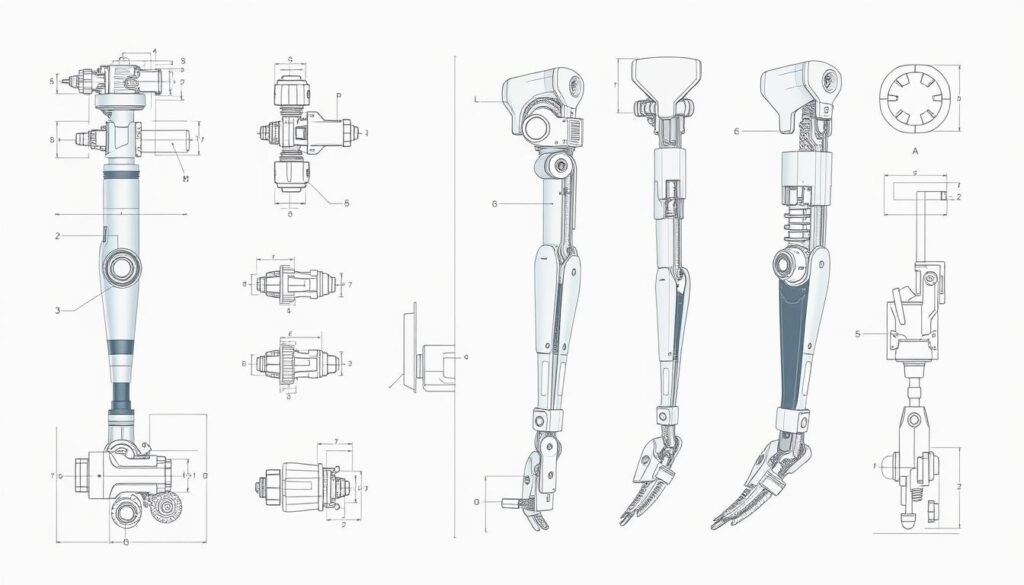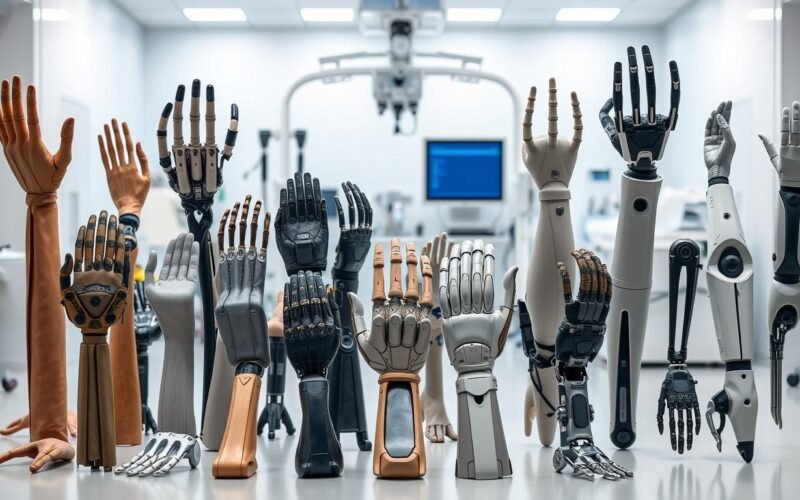Prostheses serve as artificial replacements for missing or non-functional body parts. Whether due to congenital absence, injury, or disease, these devices help restore mobility and independence. Studies show that 60-70% of amputees in the U.S. rely on prosthetic limbs, highlighting their importance in daily life.
Choosing the right prostheses involves both emotional and practical considerations. Consulting with specialists and peer communities can ease this process. Modern advancements have transformed these devices from basic cosmetic solutions to high-tech, computer-controlled limbs.
This guide explores functionality, materials, and customization options. It also covers lifestyle adaptation, helping people make informed decisions about their prosthetic needs.
Key Takeaways
- Prostheses replace missing or non-functional body parts.
- Over 60% of U.S. amputees use prosthetic devices.
- Modern prostheses offer advanced computer-controlled features.
- Consulting specialists ensures the best fit and functionality.
- Customization plays a key role in comfort and usability.
What Are Prostheses?
Modern prostheses blend medical innovation with personalized solutions for amputees. These devices restore mobility, appearance, or both, adapting to individual needs. From myoelectric hands to silicone breast forms, they transform lives daily.
Definition and Purpose
A prosthesis replaces a missing body part due to injury, illness, or congenital conditions. Cochlear implants restore hearing, while prosthetic legs rebuild walking ability. Over 60% of lower-limb amputation cases stem from diabetes complications.
Prostheses serve two primary goals:
- Functional restoration: Myoelectric arms grip objects using muscle signals.
- Cosmetic enhancement: Realistic silicone covers match skin tone.
Internal vs. External Prosthetic Devices
Prosthetic devices fall into two categories:
| Type | Examples | Key Features |
|---|---|---|
| Internal | Hip replacements, heart valves | Surgically implanted, permanent |
| External | Prosthetic legs, hook hands | Removable, customizable |
Unlike orthoses (braces/supports), prostheses fully replace lost body parts. With 200+ prosthetic foot models globally, options cater to every lifestyle.
Types of Artificial Limbs
Prosthetic technology offers diverse solutions tailored to different limb needs. Whether restoring walking ability, gripping objects, or enhancing appearance, each design serves unique purposes. About 30% of amputations result from trauma, requiring specialized devices for active lifestyles.

Lower-Limb Prostheses: Feet, Ankles, and Knees
Lower-limb devices prioritize stability and motion. Carbon fiber feet are popular for runners, while multi-axial designs adapt to uneven terrain. Hydraulic knees with weight-activated locking mimic natural gait cycles.
Key options include:
- Fixed ankle/foot: Basic support for daily walking.
- Energy-storing feet: Spring-like response for athletes.
- Microprocessor knees: Adjusts resistance in real time.
Upper-Limb Prostheses: Hands, Arms, and Elbows
Upper-limb prostheses range from simple hooks to computer-controlled arms. Cable-operated systems use shoulder movements to grip, while myoelectric hands respond to muscle signals. Sports attachments like climbing claws or cycling grips add versatility.
| Type | Best For | Example |
|---|---|---|
| Cable-controlled | Durability, low cost | Voluntary-opening hooks |
| Myoelectric | Precision tasks | Bionic hands with sensors |
Cosmetic Prostheses: Balancing Form and Function
*Cosmetic* limbs focus on realism, using silicone to match skin tone. However, many lack functional joints, limiting insurance coverage. For children, adjustable designs accommodate growth spurts—pediatric devices may need replacement every 12–18 months.
Choices often hinge on priorities:
- Function-first: Myoelectric arms for complex tasks.
- Aesthetics-first: Lifelike fingers with detailed nails.
How Prosthetic Limbs Work
The mechanics behind prosthetic devices combine innovation with real-time adaptability. These devices rely on components ranging from simple mechanical joints to AI-driven systems. Whether restoring walking or gripping, each design prioritizes seamless movement.

Mechanical and Computer-Controlled Components
Basic prostheses use mechanical parts like lock-knee mechanisms for stability. These allow users to stand or sit safely. Advanced versions integrate microprocessors that adjust resistance during stair climbing.
Key differences:
- Mechanical: Cable-operated hooks for durability.
- Computer-controlled: Myoelectric arms with muscle sensors.
The Role of Sensors and Hydraulics
Hydraulic pistons in knee prostheses mimic natural flexion, ideal for running. JFK Johnson Rehabilitation studies show microprocessor knees use sensors to analyze gait 50 times per second.
“Hydraulic systems enable fluid leg movement, even on uneven terrain.”
For upper limbs, myoelectric devices detect muscle signals to control finger precision. Passive cosmetic hands lack movement but offer lifelike appearance.
Materials Used in Modern Prosthetics
Innovative materials like carbon fiber and silicone revolutionize prosthetic design and functionality. These material choices balance durability, weight, and realism to meet diverse user needs. From Olympic running blades to everyday foot replacements, engineering breakthroughs deliver tailored solutions.
Carbon Fiber and Fiberglass for Dynamic Response
Carbon fiber excels in energy return, making it ideal for athletic prostheses. JFK Johnson studies highlight its use in sprinting blades, where 90% of energy is recycled into forward motion. Fiberglass offers a cost-effective alternative for daily-wear limbs, resisting cracks and weather damage.
Key advantages:
- Lightweight: Reduces fatigue during long-term use.
- Flexibility: Adapts to high-impact activities like jumping.
- Durability: Withstands 5+ years of constant wear.
Silicone and Other Skin-Like Materials
Silicone mimics skin texture and improves socket comfort by reducing friction. Healthdirect reports show it minimizes sweat buildup and irritation. Advanced pigments match veins, freckles, and even tattoos for seamless realism.
| Material | Best For | Limitations |
|---|---|---|
| Thermoplastic | Lightweight sockets | Less customizable |
| Laminated | Precision-fit sockets | Higher cost |
Emerging 3D-printed polymers cut costs for pediatric limbs, allowing frequent size updates. These materials reshape prosthetic care, blending science with user-centric design.
Choosing the Right Prosthesis for Your Needs
Selecting the ideal prosthesis requires balancing personal needs with technical specifications. A device that suits an athlete may not work for an office worker. Consulting experts ensures the best match for mobility and comfort.
Factors to Consider: Activity Level, Health, and Budget
Your daily routine influences prosthetic options. Runners benefit from carbon fiber blades, while desk jobs may prioritize lightweight designs. Residual limb health and phantom pain management also play critical roles.
Costs range from $5,000 for basic models to $50,000+ for advanced devices. Medicare and private insurance often cover partial expenses. In Australia, public funding supports standard prostheses.
- Activity demands: Manual labor requires durable materials.
- Underlying conditions: Diabetes may impact socket fit.
- Budget: Explore payment plans or grants if needed.
Working with a Prosthetist for Customization
A prosthetist evaluates your goals and anatomy to recommend solutions. They adjust socket fit and align components to prevent discomfort. Pediatric cases need adjustable sockets for growth spurts.
Adaptive attachments like swimming legs or gardening tools expand functionality. As one specialist notes:
“A personalized fit transforms how patients interact with their prostheses daily.”
Regular follow-ups ensure the device evolves with your needs. Whether restoring mobility or enhancing appearance, the right partnership maximizes results.
Living with Artificial Limbs
Adapting to life with a prosthesis involves daily care and active lifestyle adjustments. Proper maintenance ensures comfort, while tailored activities boost confidence and mobility. With the right approach, users can thrive in both routine tasks and recreational pursuits.
Daily Care and Maintenance Tips
Clean your prosthesis daily to prevent infections. Inspect the socket for cracks and check your residual limb for pressure sores. Healthdirect recommends using mild soap and water for silicone liners.
Moisture-wicking socks reduce skin irritation. Swap them out if damp to avoid breakdown. A well-fitted socket prevents complications—schedule adjustments with your prosthetist as needed.
- Wash silicone liners nightly to remove sweat and bacteria.
- Inspect the socket weekly for wear or loose components.
- Rotate socks during the day to keep skin dry.
Adapting to Sports and Recreational Activities
Prosthetic technology empowers users to join sports like running or basketball. Paralympic athletes use carbon-fiber blades for sprinting, while wheelchair modifications enhance court play. Rehabilitation typically takes 6–12 months for advanced devices.
| Activity | Prosthetic Solution | Key Benefits |
|---|---|---|
| Running | Energy-storing blades | High-speed responsiveness |
| Swimming | Waterproof limbs | Corrosion-resistant materials |
Organizations like Limbs4Life offer peer support for adaptive activities. For children, Limbs4Kids provides growth-adjustable designs. As one athlete shared:
“Training with my prosthetic leg taught me resilience—now I compete nationally.”
Conclusion
Today’s prostheses blend cutting-edge tech with personalized comfort, transforming lives. From sensor-driven knees to lifelike silicone materials, function meets realism seamlessly.
Consult a prosthetist to explore options tailored to your needs. Peer networks like Limbs4Life offer invaluable support during adaptation.
Patience is key—adjusting to limbs takes time. Yet, modern designs empower users to embrace active lifestyles fully. With the right device and community, mobility and health thrive.

